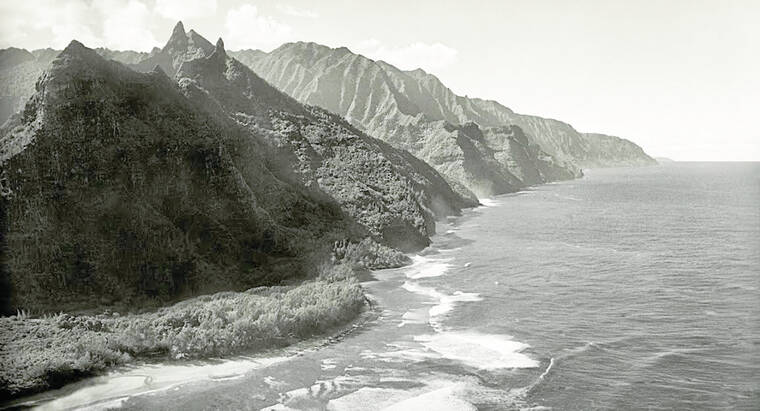LIHU‘E — Writer and photographer John Wehrheim arrived on Kaua‘i in 1971, fresh out of college, to produce a three-part series for the Sierra Club called “Paradise Lost.”
More than half a century later, an new exhibition of Wehrheim’s photos to be displayed in Prague’s 14th Century Stone Bell House Museum will bear the same name.
Through 132-prints, screenings of Wehrheim’s “The Edge of Paradise” film, and a lecture series led by Wehrheim, the exhibit will capture Kaua‘i through the 70s with a focus on Taylor Camp.
“It never was a paradise,” said Wehrheim, of Taylor Camp. “But it was really damn good.”
Over the course of several years, Wehrheim documented the rise and fall of the camp — a North Shore commune where hippies lived rent-free, and often clothes-free, in tree houses on the land of Howard Taylor, the brother of movie star Elizabeth.
The prints which will be shown in Prague range from portraits of the campers (including Kung Fu Bill Malapit, brother of Mayor Eduardo Malapit who later led the effort to shut down the camp), to scenes of nude volleyball, to aerial photographs of the Na Pali coastline.
While Wehrheim saw the camp as “a successful experiment” he said his goal in documenting it was “not just to make hippy propaganda.”
“Almost everyone at Taylor Camp was running away from something,” he said.
He described the drug addiction of campers, and a deep sadness from those who realized — despite living rent-free in the most beautiful place in the world — they were still miserable.
Through the decade, Wehrheim watched as the camp transformed from a loose colony into something more organized, with a local government — he described it as a “democracy by vibes” — infrastructure, criminal justice, and new growing families.
“In many ways, it evolved into something that was very similar to the communities these people were fleeing from,” said Wehrheim.
The hippies of Taylor Camp eventually became a political force. When it seemed that the camp was destined to be shut down, they arranged a fake meeting with Wehrheim’s wife and their preferred politician JoAnn Yukimura before they abandoned the camp, which allowed her to take “credit for getting rid of the hippies.”
“It was important for it to end then because it probably would have devolved into something less idealistic,” said Wehrheim.
Looking back on the camp, Wehrheim sees a creation that could only exist in that time and place.
“The interest and the demand is there — but it would be impossible to achieve now,” said Wehrheim, who referenced the higher cost of living and stress placed on today’s youth. “We graduated from college completely free. How many young people have that opportunity now?”
The idea of bringing the project to Prague came from Czech-native Adam Ligas, who was instrumental in putting the exhibit together.
Ligas arrived on Kaua‘i in 2016, where, in an unlikely twist of fate, he met a Czech couple at the Art Cafe Hemingway who gave him a job and introduced him to Wehrheim and his work.
“There’s so many things hidden in those photos,” said Ligas. “It’s not just about hippies.”
When he returned to the Czech, he was determined to bring Wehrheim’s work to his home country.
“I just went around Prague with his book and asked if people wanted to do something with the book and the beautiful photos,” said Ligas. “Everyone said no because I had no experience.”
Finally, he was able to get some interest from a gallery in Prague and obtained grant funding from the American Embassy.
Ligas was excited to show a slice of Kaua‘i to a European audience unfamiliar with the island.
“When you say Hawai‘i (in the Czech Republic) everybody sees some beautiful dancing woman with the coconuts,” said Ligas. “Nobody knows anything more than that.”
The exhibition will go on display Oct. 11 at the Stone Bell House Museum in Prague.


